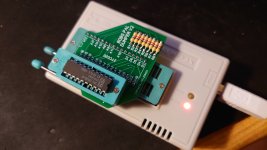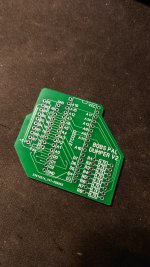Well it's a success, reads consistently as a 27C020 - no matter the manufacturer - although the AM27C020 seems to work best.
So - here's the final code revision for the GLU logic - anyone able to verify this against the GLU's own description in Apple's own hardware manual?
Name glu ;
PartNo 00 ;
Date 07/11/2020 ;
Revision 01 ;
Designer Kai Robinson ;
Company Atmel ;
Assembly None ;
Location ;
Device virtual ;
/* Dedicated input pins */
pin 1 = CLK; /* Input */
pin 2 = PB6; /* Input */
pin 3 = IRQ; /* Input */
pin 4 = WRDATA; /* Input */
pin 5 = ENABLE1; /* Input */
pin 6 = PA4; /* Input */
pin 7 = 16MCLK; /* Input */
pin 8 = PA3; /* Input */
pin 9 = RTXCB; /* Input */
pin 11 = OE; /* Input */
/* Programmable output pins */
pin 12 = RTXCA; /* Combinatorial output */
pin 13 = OUTA; /* Fixed high output */
pin 14 = BBUIRQ; /* Combinatorial output w/ output enable */
pin 15 = ENABLEL; /* Combinatorial output */
pin 16 = ENABLEU; /* Combinatorial output */
pin 17 = FLOPPYWR; /* Combinatorial output */
pin 18 = nc; /* Fixed high output */
pin 19 = FCLK; /* Combinatorial output w/ output enable */
/* Output equations */
!FCLK = 16MCLK & !OE;
nc = 'b'1;
!FLOPPYWR = WRDATA;
!ENABLEU = !ENABLE1 & !PA4;
!ENABLEL = !ENABLE1 & PA4;
!BBUIRQ = !PB6 & IRQ;
OUTA = 'b'1;
!RTXCA = !PA3 & !RTXCB & !OUTA
# PA3 & !RTXCB & !OUTA
# !PA3 & RTXCB & !OUTA
# PA3 & !RTXCB & OUTA;
/* End */





